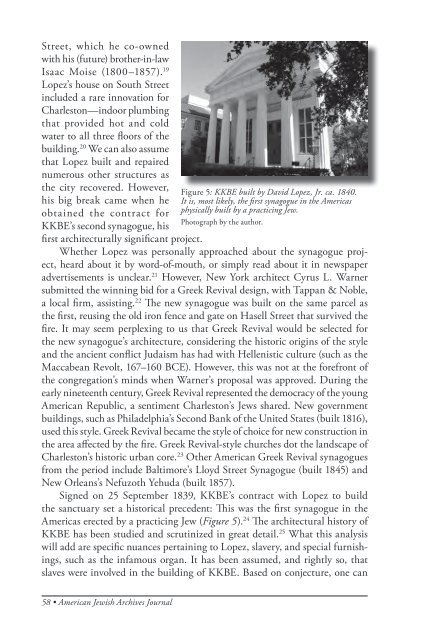American Jewish Archives Journal, Volume 64, Numbers 1 & 2
American Jewish Archives Journal, Volume 64, Numbers 1 & 2
American Jewish Archives Journal, Volume 64, Numbers 1 & 2
Create successful ePaper yourself
Turn your PDF publications into a flip-book with our unique Google optimized e-Paper software.
Street, which he co-owned<br />
with his (future) brother-in-law<br />
Isaac Moise (1800–1857). 19<br />
Lopez’s house on South Street<br />
included a rare innovation for<br />
Charleston—indoor plumbing<br />
that provided hot and cold<br />
water to all three floors of the<br />
building. 20 We can also assume<br />
that Lopez built and repaired<br />
numerous other structures as<br />
the city recovered. However,<br />
his big break came when he<br />
obtained the contract for<br />
KKBE’s second synagogue, his<br />
first architecturally significant project.<br />
Whether Lopez was personally approached about the synagogue project,<br />
heard about it by word-of-mouth, or simply read about it in newspaper<br />
advertisements is unclear. 21 However, New York architect Cyrus L. Warner<br />
submitted the winning bid for a Greek Revival design, with Tappan & Noble,<br />
a local firm, assisting. 22 The new synagogue was built on the same parcel as<br />
the first, reusing the old iron fence and gate on Hasell Street that survived the<br />
fire. It may seem perplexing to us that Greek Revival would be selected for<br />
the new synagogue’s architecture, considering the historic origins of the style<br />
and the ancient conflict Judaism has had with Hellenistic culture (such as the<br />
Maccabean Revolt, 167–160 BCE). However, this was not at the forefront of<br />
the congregation’s minds when Warner’s proposal was approved. During the<br />
early nineteenth century, Greek Revival represented the democracy of the young<br />
<strong>American</strong> Republic, a sentiment Charleston’s Jews shared. New government<br />
buildings, such as Philadelphia’s Second Bank of the United States (built 1816),<br />
used this style. Greek Revival became the style of choice for new construction in<br />
the area affected by the fire. Greek Revival-style churches dot the landscape of<br />
Charleston’s historic urban core. 23 Other <strong>American</strong> Greek Revival synagogues<br />
from the period include Baltimore’s Lloyd Street Synagogue (built 1845) and<br />
New Orleans’s Nefuzoth Yehuda (built 1857).<br />
Signed on 25 September 1839, KKBE’s contract with Lopez to build<br />
the sanctuary set a historical precedent: This was the first synagogue in the<br />
Americas erected by a practicing Jew (Figure 5). 24 The architectural history of<br />
KKBE has been studied and scrutinized in great detail. 25 What this analysis<br />
will add are specific nuances pertaining to Lopez, slavery, and special furnishings,<br />
such as the infamous organ. It has been assumed, and rightly so, that<br />
slaves were involved in the building of KKBE. Based on conjecture, one can<br />
58 • <strong>American</strong> <strong>Jewish</strong> <strong>Archives</strong> <strong>Journal</strong><br />
Figure 5: KKBE built by David Lopez, Jr. ca. 1840.<br />
It is, most likely, the first synagogue in the Americas<br />
physically built by a practicing Jew.<br />
Photograph by the author.
















